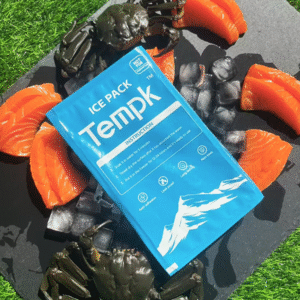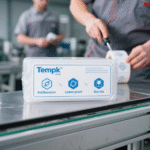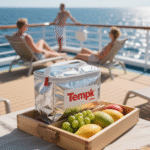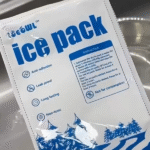Envío de carne con hielo seco garantiza que permanezca congelado y de alta calidad durante el transporte. En 2025, La industria de la logística de la cadena de frío ha experimentado avances significativos., Lo que hace que sea más crucial que nunca comprender las mejores prácticas para el uso de hielo seco en el envío de carne.. Este artículo proporciona una guía completa sobre cómo empacar y enviar carne de manera eficiente con hielo seco., incluyendo las últimas tendencias, consejos de embalaje, y pautas de cumplimiento normativo a seguir para obtener resultados óptimos.
-
Qué es el hielo seco y por qué es ideal para el envío de carne?
-
¿Cuánto hielo seco se necesita para enviar carne de forma segura??
-
¿Cuáles son las mejores prácticas para envasar carne con hielo seco??
-
¿Cuáles son las pautas reglamentarias y de seguridad para los envíos de hielo seco en 2025?
-
¿Cuáles son las alternativas ecológicas al hielo seco??
¿Qué hace que el hielo seco sea ideal para el envío de carne??
hielo seco, la forma sólida de dióxido de carbono, sublima a −78,5°C (−109.3 ° F), que es significativamente más frío que el agua helada. Esta temperatura ultrabaja lo convierte en un agente refrescante eficaz., perfecto para mantener la carne congelada durante todo el proceso de envío. A diferencia del hielo normal, El hielo seco no se derrite en el agua, prevenir fugas y crecimiento bacteriano en el contenedor de envío, asegurando así que la carne llegue en perfectas condiciones.
La capacidad del hielo seco para sublimar directamente de sólido a gas sin pasar por una fase líquida significa que no quedan residuos de agua que puedan dañar el embalaje o contaminar la carne.. Esto hace que el hielo seco sea la opción ideal para enviar carne congelada a largas distancias., particularmente para artículos como carne de res, aves de corral, y cerdo.
¿Cómo protege la sublimación su envío??
El hielo seco se sublima directamente en gas dióxido de carbono, lo que significa que no hay fase líquida. Esto elimina el riesgo de fugas o embalaje empapado que a menudo es causado por el hielo derretido.. Sin embargo, Es crucial garantizar una ventilación adecuada dentro del contenedor de envío para permitir que el gas escape.. Si el gas CO₂ se acumula sin ventilación, puede crear una presión peligrosa, dañar potencialmente el embalaje o provocar que explote.
Para evitar esto, Los paquetes que contienen hielo seco deben tener canales de ventilación o tapas que no estén selladas herméticamente.. Esto permitirá que el CO₂ escape de forma segura, similar al vapor que se escapa de una tetera.
Beneficios del hielo seco sobre el hielo normal para el envío de carne
| Característica | Paquete de hielo seco | Hielo regular | Por que importa |
|---|---|---|---|
| Temperatura de funcionamiento | −78.5 ° C / -109°F | 0°C / 32°F | Mantiene la carne por debajo del punto de congelación., prevenir el crecimiento bacteriano. |
| Cambio de fase | Sublimate al gas | Se derrite a líquido | Previene fugas, daños por humedad, y crecimiento microbiano. |
| Duración del enfriamiento | 24+ horas | 3–4 horas | El enfriamiento más duradero reduce la necesidad de reemplazos. |
| Impacto del sabor | El CO₂ de calidad alimentaria conserva el sabor | El agua de deshielo puede diluir los sabores | Garantiza que la carne conserve su sabor original.. |
| Residuo | Sin humedad | Deja agua | Mantiene el embalaje intacto y evita fugas.. |
¿Cuánto hielo seco se necesita para enviar carne??
Determinar la cantidad adecuada de hielo seco depende de varios factores, como el tamaño del envío, duración del tránsito, y condiciones ambientales.
Una regla general es utilizar 5–10 libras (2.3–4.5 kg) de hielo seco por 24 horas por cada 10–15 libras (4.5–6.8 kg) de carne congelada. Por ejemplo, envío 5 kilos (11 libras) de carne para 48 horas requeriría alrededor 12.7 libras de hielo seco. Se pueden realizar ajustes según el tipo de embalaje., aislamiento, y la época del año (Es posible que se necesite más hielo seco durante los meses más cálidos.).
Fórmula de estimación de hielo seco para carne congelada
Aquí tienes una fórmula sencilla para estimar tus necesidades de hielo seco.:
base_per_24h = 7.5 # pounds per 24 hours (midrange)
hours = 48 # transit duration
box_factor = 1.0 # 1.0 for medium box, add 0.3 for large boxes
ambient_factor = 1.0 # 1.0 for normal conditions, add 0.3 for hot weatherMejores prácticas para envasar carne con hielo seco
Empacar la carne correctamente con hielo seco es crucial para garantizar que permanezca congelada y segura durante el tránsito.. Estos son los pasos que debes seguir para optimizar tu proceso de embalaje:
1. Elija el embalaje correcto
Utilice contenedores aislados como poliestireno expandido (EPS), poliuretano (Puro), o paneles aislados al vacío (personaje). VIP ofrece un rendimiento térmico superior, lo cual es especialmente útil para envíos más largos. Estos materiales ayudan a minimizar la transferencia de calor y garantizan que la carne permanezca congelada durante períodos prolongados..
2. Coloque adecuadamente el hielo seco y la carne
Coloque una capa de hielo seco en la parte inferior del recipiente, seguido de la carne, y otra capa de hielo seco encima. Esto garantiza un enfriamiento uniforme durante todo el envío y evita el contacto directo entre el hielo seco y la carne., lo que podría causar quemaduras en el congelador.
3. Llenar espacios vacíos
Utilice materiales de embalaje como plástico de burbujas o papel kraft arrugado para llenar los espacios vacíos en el contenedor. Esto reduce el flujo de aire y ayuda a mantener una temperatura constante durante todo el envío..
4. Ventile el contenedor
A medida que el hielo seco se sublima en gas, Es esencial tener pequeños orificios de ventilación en el contenedor para permitir que escape el CO₂.. Esto evita la acumulación de presión, lo que podría dañar el embalaje o hacer que explote.
Cumplimiento normativo y etiquetado
El envío de carne con hielo seco requiere el cumplimiento de normas reglamentarias específicas. A continuación se detallan los requisitos clave:
-
Etiquetado: Marque claramente el paquete con “Hielo seco” o “Dióxido de carbono, sólido,”seguido de Y 1845 y el peso neto del hielo seco en kilogramos.
-
Clase de peligro: Colocar un Clase 9 Etiqueta de material peligroso en el paquete para cumplir con las normas de seguridad..
-
Documentación: Para envíos aéreos, incluir la documentación adecuada, como IATA PI 954 y regulaciones DOT §173.217.
Requisitos específicos del operador
Verifica siempre los requisitos con tu operador (p.ej., Fedex, Unión Postal Universal) para envíos de hielo seco. Cada transportista puede tener instrucciones específicas en el embalaje., etiquetado, y documentación.
Alternativas ecológicas al hielo seco
Si bien el hielo seco sigue siendo la solución ideal para mantener la carne congelada durante envíos largos, Existen métodos de enfriamiento alternativos que pueden adaptarse a diferentes escenarios de envío.:
-
Paquetes de gel: Ideal para envíos más cortos, Estos son refrigerantes a base de agua que mantienen la carne fría., Pero no congelado.
-
Materiales de cambio de fase (PCM): Estos materiales absorben y liberan calor a temperaturas específicas., haciéndolos adecuados para envíos de rango medio donde se requiere un control preciso de la temperatura.
-
Contenedores Refrigerados: Para envíos a granel, Los contenedores refrigerados ofrecen un método confiable para mantener la carne fría durante todo el proceso de tránsito..
Conclusión
El envío de carne con hielo seco es uno de los métodos más seguros y fiables para garantizar que permanezca congelada durante el transporte.. Entendiendo las técnicas de embalaje adecuadas., calcular la cantidad correcta de hielo seco, y cumplir con las pautas reglamentarias y de seguridad, Puede mantener la calidad y seguridad de los productos cárnicos durante todo el proceso de envío..
Siguientes pasos:
-
Asegúrese de que su equipo esté capacitado sobre el manejo del hielo seco y los procedimientos de seguridad..
-
Seleccione las cantidades de embalaje y hielo seco adecuadas para sus envíos.
-
Siempre verifique y cumpla con las pautas reglamentarias para garantizar el transporte seguro y legal de productos perecederos..
Acerca de Tempk
Tempk se especializa en brindar soluciones logísticas innovadoras de cadena de frío para la industria cárnica. Nuestros avanzados sistemas de embalaje y servicios de monitoreo de temperatura en tiempo real garantizan que sus productos lleguen a su destino de forma segura y en óptimas condiciones.. Comuníquese con Tempk hoy para obtener más información sobre cómo podemos ayudarlo a optimizar la logística de su cadena de frío para carne congelada..
























